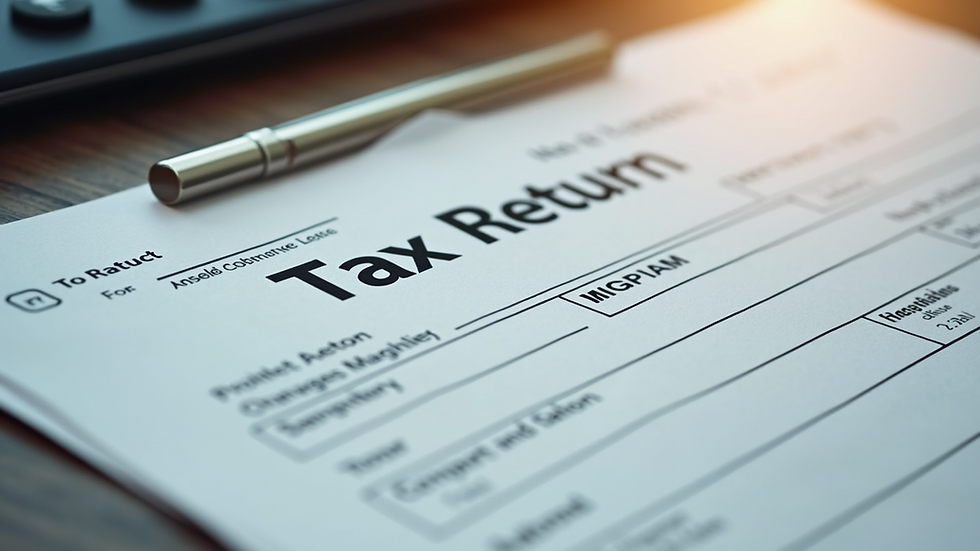Understanding the Basics of Filing Taxes Correctly
- SS AUDITORS AND TAX CONSULTANTS

- Jun 23
- 4 min read
Filing taxes can often feel like a daunting task, but understanding the basics can make the process much smoother. Navigating the tax landscape doesn’t have to be overwhelming. In this guide, we'll break down essential steps, provide actionable tips, and introduce you to valuable resources for filing taxes accurately and efficiently.
The Importance of Filing Taxes
Filing your taxes is a civic duty that impacts both individuals and society. Taxes fund public services like education, healthcare, and infrastructure, so understanding how to file correctly helps ensure these services can continue.
Moreover, filing your income tax accurately can help you avoid penalties and interest charges from tax authorities. In fact, according to the IRS, nearly 80% of taxpayers who file their own taxes incorrectly incur penalties. It is essential to understand the various forms and deductions you are eligible for in order to maximize your refund and minimize your tax liabilities.

Essential Steps for Filing Taxes
To file your taxes correctly, follow these essential steps:
Gather Your Documents: Collect all necessary documents, including W-2s, 1099s, and any other income statements. You may also need receipts for deductions.
Choose Your Filing Status: Your filing status determines your tax rates and eligibility for various tax credits. Common statuses include Single, Married Filing Jointly, and Head of Household.
Fill Out the Correct Tax Form: Depending on your financial situation, you’ll use different forms such as 1040, 1040A, or 1040EZ. These forms come with different complexity levels, so choose one that matches your needs.
Claim Your Deductions: Tax deductions decrease your taxable income. Common deductions include mortgage interest, student loan interest, and charitable contributions.
Review and Submit Your Return: Double-check all the information for accuracy before submitting. Consider using tax software or a tax professional for peace of mind.
By following these steps, you can simplify the filing process significantly.

Which is the best site for filing Income Tax Return?
When choosing a platform for filing your income tax returns, the best site will depend on your specific needs. Popular tax software options include TurboTax, H&R Block, and TaxSlayer. Each platform has its strengths:
TurboTax: Known for its user-friendly interface and comprehensive guides, TurboTax is ideal for individuals who prefer straightforward navigation.
H&R Block: Offers in-person assistance and an easy-to-use online platform. It's a great choice for those who want both online and offline support.
TaxSlayer: Often favored for its affordability, TaxSlayer provides the essential features for efficient filing without breaking the bank.
While there’s no single “best” site, consider your budget, complexity of your tax situation, and needed support when making your choice.
What You Need to Know About Deductions and Credits
Understanding tax deductions and credits can significantly reduce your tax bill. Deductions lower your taxable income, while credits reduce the amount of tax you owe.
Some common deductions include:
Standard Deduction: Automatically available to all taxpayers. The amount varies based on filing status, for example, $12,400 for single filers in 2020.
Itemized Deductions: Available for those who may benefit from listing specific expenses, such as mortgage interest, medical expenses, and state taxes.
Tax credits that you should be aware of include:
Earned Income Tax Credit (EITC): Designed to benefit low to moderate-income working individuals and families.
Child Tax Credit: Offers financial relief to families with qualifying children; for tax year 2020, taxpayers may claim up to $2,000 per child.
By thoroughly understanding deductions and credits, you’ll be better positioned to optimize your tax return and keep more of your hard-earned money.

Common Mistakes to Avoid When Filing Taxes
Even the smallest mistake can lead to frustrating setbacks. Here are some common mistakes to avoid:
Incorrect Personal Information: Ensure your name, Social Security number, and filing status are accurate. Even minor discrepancies can lead to processing delays.
Math Errors: Double-check calculations, especially when calculating deductions and credits. Use tax software with built-in checks for added accuracy.
Missing Deadlines: Be aware of key dates for filing taxes. Late submissions may lead to penalties, so mark your calendar!
Ignoring State Taxes: Don’t forget about state tax obligations. Each state has its own rules and requirements; ensure you comply accordingly.
Neglecting to Keep Records: Keep copies of your filed return and supporting documents for at least three years. This becomes crucial in case of audits.
By being aware of these common pitfalls, you can file taxes correctly and avoid unnecessary stress.
Final Thoughts on Filing Taxes
Understanding the basics of filing taxes not only aids in compliance but also empowers you to make knowledgeable financial decisions. From choosing the right filing sites to understanding deductions and avoiding mistakes, being proactive can save you time and money.
As you prepare for the next tax season, remember the significance of correct income tax returns filing. Familiarizing yourself with tax essentials now can lead to a smoother experience down the line.
If you're still uncertain about the complexities of your taxes, don't hesitate to consult with a tax professional. They can offer tailored advice to your financial situation and help ensure you’re filing correctly. Remember, being informed is your best asset when it comes to taxes.
Let this guide serve as a roadmap for a successful tax-filing experience. Happy filing!


Comments